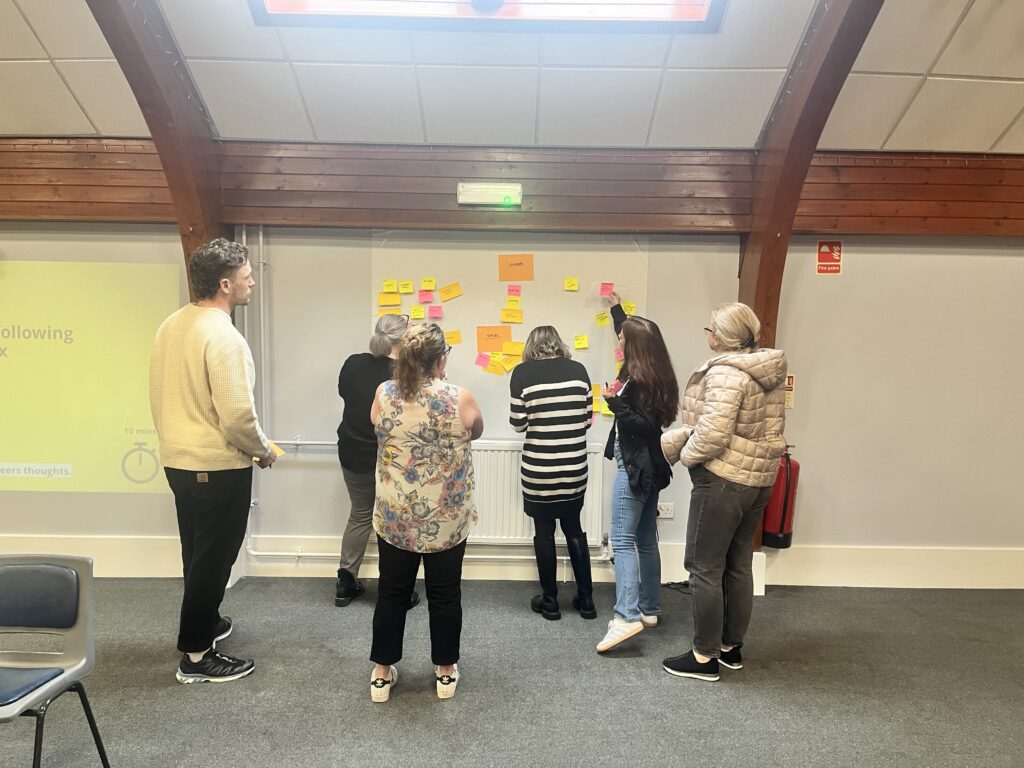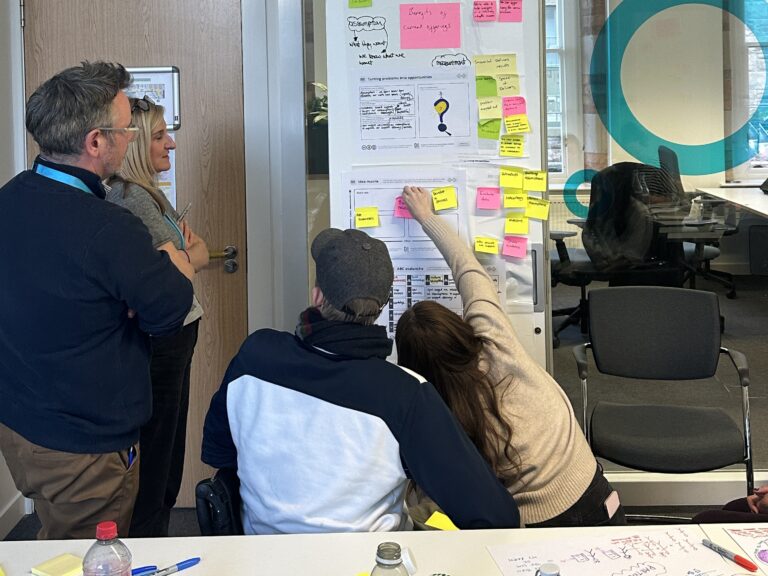Discover how the Dumfries and Galloway Local Employability and Skills Partnership (D&GLEP) and the Service Design Academy (SDA) are transforming employability services by taking a person-centred approach. By involving communities in the design process, they create innovative, sustainable solutions that enhance employment opportunities and strengthen community bonds. This approach, described by one of the participants as “working like magic,” ensures services truly meet local families’ needs.
By focusing on quality employment opportunities and supportive policies, the Scottish Government aims to create a more equitable and prosperous future for all children.
Improving parental employment requires taking a multifaceted approach that addresses both immediate and long-term needs of families. It enhances economic stability, supports child development, breaks the cycle of poverty, and reduces reliance on social security. Child poverty – Poverty and social justice – gov.scot
Since 2021, the Service Design Academy (SDA) has partnered with the Dumfries and Galloway Local Employability and Skills Partnership (D&GLEP) with the goal of improving parental employment by building the skills of frontline keyworkers, strategic partners and community members. This is to ensure that their voices are at the heart of service development, enabling a more inclusive and effective approach to addressing community needs.
By building service design skills across this diverse group of stakeholders, their unique perspectives and experiences can be leveraged to create solutions that are more innovative, relevant, and sustainable. This collaborative effort not only empowers individuals but also strengthens the overall impact and success of the services provided.
The Service Design Pilot in Stranraer
Context
In March 2023, SDA and D&GLEP embarked on a pilot project in Stranraer, aiming to understand the perspectives of local families and inform the participatory budgeting and commissioning of new services through an Innovation Fund.
Approach
SDA crafted a training programme for a wide and diverse range of people across the community including employability support workers and third sector partners. We combined face-to-face interactive workshops with online mentoring sessions, as the group gathered information through a variety of user research techniques including in depth interviews and pop-up research. This initiative was designed to equip this wide range of stakeholders with the skills needed to engage deeply with parents and families through prolonged user research and co-design activities.
Impact
The impact of this 12–week programme was significant. The 20-minute neighbourhood hypothesis was tested, demonstrating how employability services could be developed in collaboration with parents and families. This approach not only generated innovative ideas for community projects but also strengthened the connections between key workers and the local community. By fully involving families in decision-making processes, sustainable and collaborative new ways of working were developed within DGLEP.
Developing a service design approach in Kirkconnel and Kelloholm
Encouraged by the success in Stranraer, this approach was extended to Kirkconnel and Kelloholm in spring 2024.
Context
Families in these villages face challenges such as limited employment opportunities, economic instability, and access to essential services. The decline of local industries has led to reduced job prospects, while poverty and social isolation further impact their quality of life.
The project, co-designed with DGLEP and the local community development trust Kirkconnel and Kelloholm Development Trust (KKDT), aimed to improve employability services by deeply understanding local needs and co-designing solutions to improve employment opportunities to reduce child poverty.
Approach: Community Consultants
Our journey in Kirkconnel and Kelloholm began with engaging and supporting local community members, employability key workers and stakeholders. The local community trust provided support in identifying local people to get involved. SDA provided service design training to locally recruited residents as project community consultants. These community consultants were empowered to engage with other local parents and gather valuable user experiences.
Through a series of workshops and ongoing coaching, the community consultants conducted research, analysed data, and co-designed solutions with families and stakeholders.

Key themes
Throughout the project, several key themes emerged:
- improved access to health and wellbeing services
- increased availability of local childcare services
- ensuring that everyone is aware of the services and opportunities available to them.
A significant outcome was the recognition of the need for a physical space where the community could meet, access services, and obtain information. Using tools like the service model canvas, the community co-designed the key components of a Community Hub.
Impact: Increased Community Engagement
The successful prototyping of the Community Hub led to increased community engagement and support for local services. Positive feedback from community members and local support organisations highlighted the success, securing funding for the development of the Community Hub.
Listening and acting on the insights and experiences shared by local families has ensured that new service resonates with the community they are designed to serve.
Milestone - Community Hub Event (October 2024)
A significant milestone in the Kirkconnel and Kelloholm project was the community hub event held in October. This event was a culmination of efforts to create a physical space where the community could meet, access services, and obtain information. The event saw a fantastic turnout:
42 families
52 adults
88 children
53 people from D&GLEP and community organisations
~10% of the community population

The event featured a family fun and information day, which received very positive feedback from both families and partner organisations. It was a vibrant demonstration of community engagement and support for local services. The success of this event underscored the importance of having a dedicated community space and highlighted the community's enthusiasm for the project.
Lynne Burgess, Employability, Skills and Partnerships Manager at Dumfries and Galloway Council, shared her thoughts on our collaboration:
“Dumfries and Galloway Council is committed to working alongside residents to identify solutions to challenges and create opportunities in our communities. We were delighted to work with the Service Design Academy on our 20-minute neighbourhood project in Stranraer. The skills, experience, innovation, and enthusiasm brought by SDA have been invaluable, and the feedback from the community has been incredibly positive.”
John King from the Service Design Academy shares his enthusiasm for the success of this approach:
“We are thrilled that D&GLEP has embraced a truly person-centred approach. Moreover, and most importantly, it was music to our ears hearing feedback from a community consultant that this approach “works like magic”.
The impact of making change for good by having the community actively involved in articulating the issues and in the decision-making process really feeds into what D&GLEP envisioned and wanted the community’s experience to be.
Brave leadership from D&GLEP was pivotal in making this collaboration so successful. Their willingness to trust the process to fully engage with the community ensured that the services developed are reflective of the community’s needs and aspirations.”

Our learnings
We learned that the knowledge and connections on the ground must be tapped into. Engaging with key stakeholders from the very beginning is crucial.
1. Build skills and confidence
Create a focus on building community engagement skills by developing and delivering training programmes for frontline workers and community members means that projects can be sustainable and replicable.
Our programmes covered service design principles, user research methods, and co-design techniques. Offering more advanced accredited Professional Development Award training for project keyworkers gave them the confidence to lead on initiatives.
2. Co-design
Facilitate collaborative workshops where community members and stakeholders can co-design services together.
Tools like the service model canvas and 5 success steps can help visualise and plan these services. Fully involving the community in budgeting decisions through participatory budgeting ensures that funding is allocated to services that meet their needs.
3. Prototype and test solutions
Develop low-fidelity prototypes of proposed services or community hubs.
Gather feedback from the community to refine these prototypes. Implement pilot projects to test the feasibility and impact of new services and use the findings to make adjustments.
4. Evaluate and iterate
Establish mechanisms for continuous feedback from the community.
Regularly evaluate the impact of services and make improvements based on this feedback. Sharing the outcomes and lessons learned with all stakeholders ensures transparency and continuous improvement.
5. Give it time
Ensuring meaningful engagement with flexible scheduling, ongoing support, and participant empowerment through training and encouragement.
Working with busy frontline workers and community members to design new services presents challenges such as limited time, balancing existing responsibilities, and building confidence in their ability to contribute effectively.

To find out how you can build your team’s skills, have a look at our website or arrange a chat with SDA [email protected]



